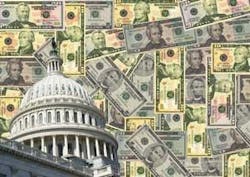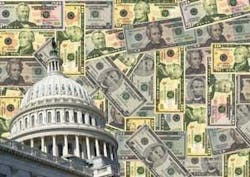Bailout bill tax savings … What you need to know
By Mark E. Battersby
Talk about last-minute tax law changes that will affect many within the dental industry, including equipment manufacturers and dealers. Congress passed and, 90 minutes later, the president signed into law a historic financial markets rescue bill, the Emergency Economic Stabilization Act of 2008. Although the new law’s primary purpose is to solve the credit crunch in the financial markets, it also serves as one of the largest tax bills in recent years.
Included as part of this bill were almost 300 changes to our tax laws — tax breaks expected to save taxpayers a whopping $150 billion. The new law includes a much-anticipated alternative minimum tax (AMT) “patch,” an extensive package of tax extenders, energy incentives, disaster relief, and more … much more.
Designed specifically for small businesses and small business owners who are, according to our lawmakers, the ones with large amounts of deposits at risk, a portion of the bailout bill raised the FDIC and National Credit Union Share Insurance Fund deposit insurance limits from $100,000 per account, to $250,000. Remember, however, the increased levels are only temporary, expiring after 2009.
Fewer need dread the AMT
The bill boosts the alternative minimum tax exemption amounts for individuals for 2008, and provides that — at least for 2008 — personal, nonrefundable credits may offset AMT and regular tax. Additionally, the new law also liberalizes the AMT refundable credit amount rules.
The bill increases the income threshold where people begin to feel the effects of the AMT. Although originally designed to prevent the wealthy from avoiding paying taxes, because lawmakers failed to index the cut-off point for inflation, it has affected an increasing number of middle-class taxpayers. Each year, Congress has passed a series of “patches” to boost the threshold. The patch included in the new law raises the 2008 tax year AMT exemption amounts to $69,950 for married couples filing jointly and $46,200 for single taxpayers. Total savings to taxpayers will be almost $62 billion.
Currently, a taxpayer receives an exemption of $33,750 (individuals) and $45,000 (married filing jointly) under the AMT. Current law also does not allow personal credits against the AMT. At the end of 2008, lawmakers increased the exemptions to $44,350 and $66,250, respectively, and allowed the personal credits against the AMT to hold the number of taxpayers subject to the AMT at bay. Although that provision expired at the end of 2007, Congress has increased the exemption amounts to $46,200 (individuals) and $69,950 (married filing jointly) for 2008. The proposal will also allow personal credits against the AMT. Estimated savings are almost $62 billion over 10 years (the way Congress measures the cost to the Treasury and the savings to taxpayers).
Leasehold improvements
Earlier tax law changes shortened the cost recovery period of certain improvements made to leased business and restaurant property from 39 to 15 years. The new law not only extends that tax break until the end of 2009, it allows retail businesses to benefit from the shortened recovery period, but only for 2009. The estimated savings from this provision is $8.7 billion over 10 years.
Qualified leasehold improvements will be eligible for a 15-year recovery period rather than a 39-year period. This means a faster and larger write-off for these improvements as well as certain improvements to so-called “retail space.”
Saving taxes on energy credits
The new law extends a number of energy tax incentives, some targeted to consumers and others to producers and manufacturers. In addition to tax credits for utilizing solar or altnerative energy in the dental equipment or supplies business, there is also a unique tax deduction available to anyone making a commercial building more energy-efficient.
Tax deductions for energy-efficient buildings were extended through December 31, 2013, and are expected to generate tax savings in excess of $890 million over a 10-year period. Rather than a deduction for the cost of equipment or improvements to make a commercial building more energy-efficient, the amount deductible is up to $1.80 per square foot of building floor area for buildings achieving a 50% energy savings target.
The energy savings must be accomplished through energy and power cost reductions for the building’s heating, cooling, ventilation, hot water, and interior lighting systems.
Researching R&D tax credits
The bill would extend that unique tax credit, an offset against the operation’s tax bill rather than a deduction, in an amount equal to 20% of the amount by which a taxpayer’s qualified research expenses in a tax year exceed its base amount for that year. Although the provision expired December 31, 2007, the new law extends it until the end of 2009.
The new law also increases the alternative simplified credit from 12% to 14% for the 2009 tax year and repeals the alternative incremental research credit for the 2009 tax year. Applying to all amounts paid or incurred after December 31, 2007, the estimated tax savings is roughly $19 billion over 10 years. Obviously, as is the case with many of these tax provisions, understanding and applying them will require the assistance of a tax professional.
Plugging in a special tax credit
The bill establishes a unique tax credit for plug-in electric drive vehicles. The credit for passenger vehicles and light trucks ranges from $2,500 to $7,500.
Under the new rules, any dental equipment or supplies dealer or manufacturer purchasing a plug-in electric vehicle will benefit from tax savings estimated to exceed $758 million over the next ten years.
Taxpayers may claim the full amount of the allowable credit up to the end of the first calendar quarter after the quarter in which the total number of qualified plug-in electric vehicles sold in the U.S. exceeds 250,000. The credit is available against the alternative minimum tax (AMT).
Transportation fringe benefits
If a plug-in electric vehicle is not in the cards, there is another tax break, this one a unique fringe benefit. Under our tax rules, employees can exclude certain employer-provided transportation fringe benefits from income, such as transit passes and van pooling. The new law extends similar treatment to employer-provided transportation fringe benefits paid to employees who commute by bicycle. The exclusion amount is only $20 per month and applies to such things as storage. The benefits begin after December 31, 2008.
The new markets tax credit
The New Markets Tax Credit is one of the few incentives in our tax law to encourage taxpayers to invest in or make loans to small businesses in economically distressed areas. In today’s credit crunch, extension of the New Markets Tax Credit may help many dental sales businesses secure financing that otherwise might not be available.
Created to increase investment in low-income communities, the total credit equals 39% of the investment over seven years. Set to expire at the end of 2008, the New Markets Tax Credit has been extended through December 2009, generating an expected tax savings of $1.3 billion over 10 years.
On the upside of tax savings
Although these tax breaks passed with only minimal “offsets” or “revenue enhancers,” there are a few provisions designed to offset the loss to the U.S. Treasury. Approximately $44 billion in offsets mean tax increases for some. The FUTA surtax is one such area.
The Federal Unemployment Tax Act (FUTA) imposes a 6.2% gross tax rate on the first $7,000 paid annually by employers. In 1976, Congress passed a temporary surtax of 0.2% of taxable wages to be added to the permanent FUTA tax rate. The temporary surtax subsequently has been extended through 2008. This bill extends the surtax for one year only — at an estimated cost to employers of $1,474 billion over 10 years.
Coping with and without coming attractions
There is a lot more tax legislation on tap. At the top of the list is the question of whether to extend many of the temporary provisions enacted in the Economic Growth and Tax Relief Reconciliation Act of 2001 (EGTRRA), such as the lower individual marginal income tax rates and relief of the marriage penalty. EGTRRA also repealed the federal estate tax but just for 2010. These temporary provisions will expire after 2010. Additionally, lower capital gains and dividend tax rates will sunset within the next few years.
Although the primary purpose of the Emergency Economic Stabilization Act of 2008 was to solve the credit crunch in the financial markets, it is also one of the largest tax bills in recent history. However, under Congressional rules, the bill’s tax savings had to be computed over a 10-year period for budget purposes. Fortunately, the lion’s share of that expected outlay occurs in the 2008 and 2009 tax years. Consequently, tax planning takes on a special urgency for every dental equipment and supplies manufacturer and dealer, business owner, and professional, who wants to take full advantage of these new, and — in many cases — temporary, tax breaks.

